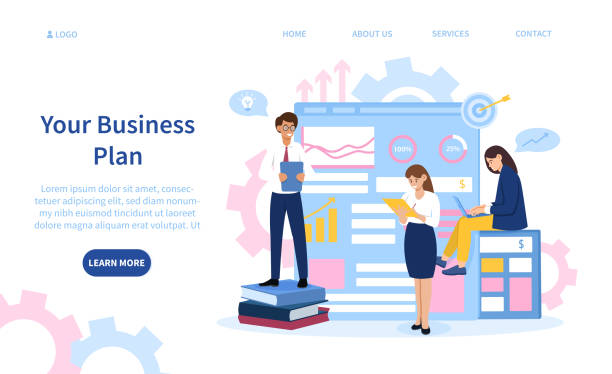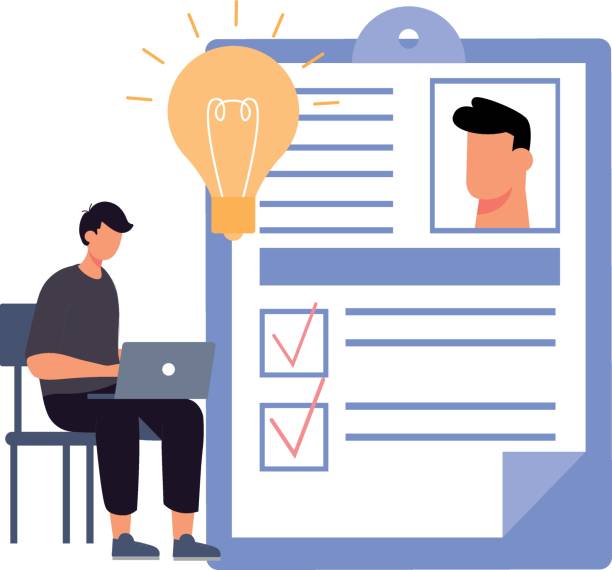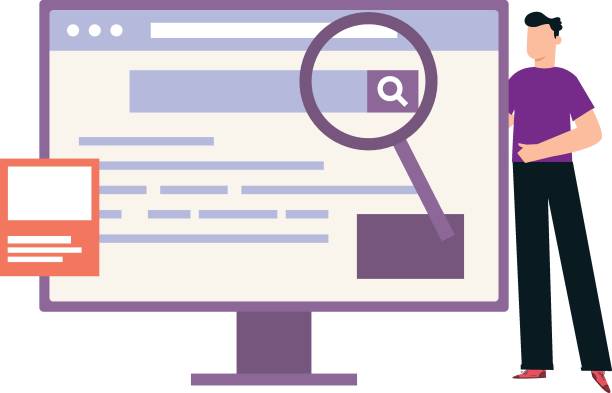Why Multilingual Website Design is Essential for Global Success?

In today’s world where geographical boundaries have become meaningless in the digital space, access to global markets is considered a key competitive advantage for any business.
One of the most powerful tools to achieve this goal is #multilingual_website_design.
Single-language websites often overlook a vast portion of #global_markets and potential customers.
Imagine your business only operates in Persian, while a significant percentage of the world’s population speaks other languages and prefers to read content in their native language.
With a multilingual site, you will be able to communicate with a wider audience, gain their trust, and ultimately, significantly increase your chances of sales and #online_business development.
This type of design allows you to localize your content, not just simple translation, but also consider the culture, values, and expectations of target audiences in each region.
This approach ensures that your message is conveyed correctly and has the desired impact.
Investing in multilingual website design is not just an expense, but a strategic investment for the future of your business in the international arena.
Tired of your company’s website not meeting your expectations? Design a professional website with Rasaweb that truly reflects your business.
✅ Increase new customer acquisition and sales leads
✅ Enhance your brand’s credibility and trust with your audience
⚡ Get a free website design consultation!
Challenges and Critical Considerations in Building a Multilingual Website

As the benefits of multilingual website design are evident, its challenges should not be overlooked.
A simplistic approach to content translation and publication can lead to project failure.
The first and most important challenge is content management in different languages.
Should your content be exactly the same, or should it be localized for each language? This is where the importance of understanding cultural differences reveals itself.
A sentence or image that is perfectly normal in one culture may be considered offensive or inappropriate in another.
Therefore, the translation team must not only be fluent in the language but also have a deep understanding of the target cultures.
Another challenge is technical issues.
Choosing the right URL structure (subdomain, subdirectory, or separate domain), proper implementation of hreflang tags for SEO, and ensuring website loading speed in different parts of the world, all require technical expertise.
Ignoring any of these can lead to a poor user experience, low search engine rankings, and ultimately, loss of audience.
Also, maintaining brand consistency across all languages, without altering its core message, is an art in itself.
Multilingual website design requires careful planning and cautious execution to unleash its true potential.
Technical Structure and Architecture of Multilingual Website Design

The technical implementation of a multilingual website is the backbone of its success.
Choosing the right architecture and tools will determine the efficiency and scalability of your site.
One of the key decisions in multilingual website design is the choice of Content Management System (CMS).
Platforms like WordPress with plugins such as WPML or Polylang, Drupal with powerful built-in modules, or Joomla, are popular choices for multilingual sites.
Headless CMS platforms also provide high flexibility for developers and allow content management independently of the display layer.
For SEO and user experience, the site’s URL structure is very important.
Three main approaches include using subdirectories (e.g., mysite.com/fa/, mysite.com/en/), subdomains (e.g., fa.mysite.com, en.mysite.com), or separate domains (e.g., mysite.ir, mysite.com).
Each has its own advantages and disadvantages that should be chosen based on your goals and budget.
For example, subdirectories are generally considered stronger for SEO because all languages are under one main domain.
The database must also be capable of storing multilingual content, which is often done by creating separate tables for each language or using multilingual columns in a single table.
These specialized and educational aspects should be carefully examined in the early stages of design to prevent future complexities.
| Method | Example | Advantages | Disadvantages | SEO Recommendation |
|---|---|---|---|---|
| Subdirectories | example.com/en/ |
|
|
Usually the best option |
| Subdomains | en.example.com |
|
|
Good option, but less than subdirectories |
| Separate Domains | example.com and example.de |
|
|
Suitable for completely separate markets |
Content Strategy and Localization in Multilingual Websites

Creating successful content for a multilingual website goes beyond word-for-word translation.
This process involves the art of localization; adapting content to the language, culture, and even social sensitivities of the target audience.
For your multilingual website design to be truly effective, you must have a deep understanding of the markets you are targeting.
This means researching common idioms, jokes, proverbs, and even appropriate colors and images for each culture.
Your content should convey a natural feel in the target language, so that the audience feels the content was originally written for them.
This includes translating main content, blog articles, product descriptions, calls to action (CTAs), and even system error messages.
Using native translators who are experts in your business field ensures the highest level of content quality and accuracy.
Also, creating a specialized glossary and style guide for each language helps maintain consistency across all site content.
This guiding approach helps you avoid common cultural mistakes and establish a stronger connection with your international audience, which is essential for any content marketing strategy.
Research shows 80% of customers trust companies with professional websites more. Does your current site inspire this trust?
With Rasaweb’s corporate website design services, solve the problem of customer distrust and poor online image forever!
✅ Create a professional image and increase customer trust
✅ Attract more sales leads and grow your business
⚡ Get a free corporate website design consultation
Search Engine Optimization (SEO) for Multilingual Websites

Multilingual SEO is one of the most complex and crucial aspects of multilingual website design.
Without proper SEO, even the best content cannot reach your international audience.
The most important step in this regard is the correct use of the `hreflang` tag.
This tag tells search engines like Google that different pages of your site are alternate versions of each other for different languages or regions.
Improper `hreflang` implementation can lead to duplicate content issues and lower your site’s ranking.
The next step, keyword research in each language.
Keywords that are effective in one language may not have the same meaning or popularity in another.
Using local keyword research tools and understanding the search intent of native users is crucial.
Also, you should consider an international link-building strategy.
Receiving backlinks from reputable and relevant sites in each language can increase your site’s authority in that particular market.
Your content should be optimized for search engines in each region and include appropriate meta tags, descriptions, and URLs.
This part of multilingual website design, is specialized and educational in nature and requires great precision.
Ignoring multilingual SEO means losing valuable organic traffic from international markets.
User Experience (UX) and Visual Design in International Websites

User Interface (UI) and User Experience (UX) design play a vital role in multilingual website design.
A beautiful site with great content, if it has a poor user experience, cannot retain users.
One of the first things a user notices is the ability to change language.
This option should be clearly and easily accessible, usually in the header or footer of the site.
Using standard icons like flags or language names instead of language codes (e.g., EN for English) can help users identify it.
The visual design of the site must be acceptable across different cultures.
Colors, images and even fonts can have different meanings in various cultures.
For example, the color red in some cultures symbolizes love and happiness, while in another, it may mean danger.
Ensuring that texts are displayed correctly in all languages (without clutter or truncated words) and that the page layout is properly adjusted for right-to-left languages (like Persian and Arabic) is of paramount importance.
Website loading speed in all geographical regions is also a key factor in UX.
A successful multilingual website is one that gives its users the feeling that it was designed for them and in their language.
This aspect of multilingual website design is an important explanation for establishing effective communication with audiences.
Practical Tools and Platforms in Multilingual Website Development

For success in multilingual website design, choosing and using the right tools is crucial.
These tools can facilitate the translation process, content management, and even SEO optimization.
Modern Content Management Systems (CMS) like WordPress with specialized plugins such as WPML and Polylang, or Drupal and Joomla with built-in multilingual capabilities, are popular choices.
These CMSs allow for easy management of content in different languages.
In addition to CMS, Translation Management Systems (TMS) also play a key role.
These platforms help organize the translation process, collaboration among translators, and quality review.
Tools like Memsource, Phrase or Smartling are examples of TMS that offer features such as Translation Memory and Glossaries which help maintain translation consistency and quality over time and reduce costs.
Also, automated quality assurance (QA) tools can help identify errors in translation, formatting, and links.
For multilingual SEO, tools like Ahrefs and Semrush help you research keywords in different languages and monitor your site’s performance in local search engines.
This part of multilingual website design is educational and specialized in nature and is essential for any developer or project manager planning to build an international website.
| Tool/Platform Category | Tool/Platform Name | Key Features | Suitable for |
|---|---|---|---|
| CMS Plugins (WordPress) | WPML |
|
WordPress sites that require full translation |
| CMS Plugins (WordPress) | Polylang |
|
WordPress sites with limited budget or simpler translation needs |
| Translation Management System (TMS) | Memsource (Phrase) |
|
Large companies and teams with high volume of translation |
| Translation Management System (TMS) | Smartling |
|
Businesses that require a complete localization ecosystem |
| Multilingual SEO Tools | Ahrefs / Semrush |
|
SEO specialists and international digital marketers |
Marketing and Promotion of Multilingual Websites in Global Markets

Building a multilingual website is only half the battle; the other half is dedicated to marketing and promoting it in target markets.
For your multilingual website design to be profitable, you need to ensure that target audiences are aware of its existence.
International marketing strategies must align with content localization approaches.
This includes content marketing campaigns in different languages, geographically and language-targeted PPC (Pay-Per-Click) advertising, and activity on popular social networks in each region.
For example, a successful campaign in Latin America might require a strong presence on WhatsApp, while in China different platforms like WeChat are popular.
Using local influencers or collaborating with local websites and news media can also be effective in raising awareness of your brand in new markets.
News about your site’s multilingual capabilities, such as launching new languages or products tailored to specific cultures, can generate public interest.
An entertaining and engaging approach to marketing can create a deeper connection with audiences and encourage them to explore your site further.
Multilingual website design is a long-term investment that can yield tremendous returns with smart marketing.
Did you know that 94% of the first impression of a company is related to its website design?
Rasaweb, by providing professional corporate website design services, helps you create the best first impression.
✅ Create a professional and trustworthy image for your brand
✅ Attract potential customers more easily and improve online presence
⚡ Get a free corporate website design consultation
Continuous Maintenance and Updates of Multilingual Website

After launch, multilingual website design requires continuous maintenance and updates.
Outdated or inaccurate content can harm your site’s credibility and disrupt user experience.
This includes updating product information, blog articles, announcements, and any other dynamic content in all languages.
The translation and localization team should be regularly prepared to translate new content or revise existing content.
Monitoring site performance in different regions of the world, including loading speed and proper functionality of features, is crucial.
Using web analytics tools like Google Analytics helps you understand user behavior in each language and identify opportunities for improvement.
Also, you must comply with local laws and regulations regarding data privacy (such as GDPR in Europe or CCPA in California) and other e-commerce related laws in each country you serve.
This may include updating privacy policies, terms and conditions, and contact information.
Security guidelines must also be continuously applied to protect your site from cyberattacks.
Active and specialized maintenance of a multilingual website, is key to maintaining continuous customer relationships and ensuring its long-term success in the global market.
The Future of Multilingual Website Design and Global Outlook

The future of multilingual website design is intertwined with technological advancements, especially in the field of Artificial Intelligence and machine translation.
While machine translation still cannot fully replace human localization, AI tools are becoming increasingly accurate and efficient and can be used as a powerful aid in the translation process.
These advancements can reduce the cost and time required to create and maintain multilingual sites, allowing even smaller businesses to expand globally.
Furthermore, future trends may include content personalization based on geographical location, language, and even user browsing history.
This means that the website can automatically provide relevant and localized content to each visitor, even if they have not explicitly selected a language.
The question that arises is whether this level of automation can replace deep cultural understanding or merely facilitate the process? A precise analysis of these trends shows that multilingual website design is not only a current necessity but will continue to evolve in the future.
With increasing internet access worldwide and a growing number of non-English speaking users, the potential for growth for businesses investing in multilingual website design will remain infinite.
This is a thought-provoking content on how the future will shape these global connections.
Frequently Asked Questions
| No. | Question | Answer |
|---|---|---|
| 1 | What is multilingual website design? | Multilingual website design means building a website whose content is available to users in several different languages. This is usually done through a simple user interface for language switching. |
| 2 | Why should we design a multilingual website? | Designing a multilingual website helps you reach more audiences worldwide, provide a better user experience for international users, and improve your global SEO. |
| 3 | What are the main methods of implementing multilingualism on a website? | The main methods include using subdomains, subdirectories, or URL parameters for each language, as well as using completely separate domains for each language. |
| 4 | Is it better to use subdirectories or subdomains for SEO? | In terms of SEO, both subdirectory and subdomain methods can be effective. However, many SEO experts prefer subdirectories due to better transfer of main domain authority. |
| 5 | What are the important tips for translating multilingual site content? | Translation should be done by native translators, content should be localized (localization) in addition to translation to match the target audience’s culture, and pure machine translation should be avoided. |
| 6 | What is the role of the hreflang tag in multilingual site SEO? | The hreflang tag helps search engines like Google display the correct language and regional version of a page to the appropriate users, which also prevents duplicate content issues. |
| 7 | Can a website be made multilingual without coding? | Yes, in Content Management Systems (CMS) like WordPress, powerful plugins such as WPML or Polylang exist that enable making a website multilingual without requiring coding. |
| 8 | What are the challenges of multilingual website design? | Challenges include translation management, content localization, adhering to SEO principles for each language, technical support for different languages, and ensuring design consistency across different languages. |
| 9 | What is the difference between translation and Localization? | Translation is merely converting words from one language to another, while localization involves adapting content to the culture, customs, currency, date and time formats, and even appropriate colors for the target audience. |
| 10 | What is the best user experience (UX) for language switching? | A clear and accessible language switcher (usually in the header or footer), using language names instead of flags (due to regional diversity), and maintaining the user’s position after changing the language are important UX tips. |
And other services of Rasa Web Advertising Agency in the field of advertising
Smart SEO: A new service to increase website traffic through SEO-driven content strategy.
Smart Data Analysis: A quick and efficient solution to improve SEO ranking by focusing on intelligent data analysis.
Smart Sales Automation: An innovative platform to improve sales increase by optimizing key pages.
Smart Link Building: Designed for businesses seeking online growth through precise audience targeting.
Smart Digital Branding: A combination of creativity and technology for digital branding through intelligent data analysis.
And over hundreds of other services in the field of internet advertising, advertising consultation, and organizational solutions
Internet Advertising | Advertising Strategy | Advertorial
Resources
Benefits of Multilingual Website Design for Business
Strategies for Global Business Expansion
Key SEO Tips for Multilingual Websites
How to Build a Professional Multilingual WordPress Site
? With Rasaweb Afarin digital marketing agency services, see your business at the peak of competitiveness. From custom website design and SEO to targeted advertising campaigns, we offer comprehensive solutions for your growth and success. To learn more about our services and get a consultation, contact Rasaweb Afarin’s expert team today and build your digital future.
📍 Tehran, Mirdamad Street, next to Central Bank, Southern Kazeroun Alley, Ramin Alley, No. 6



